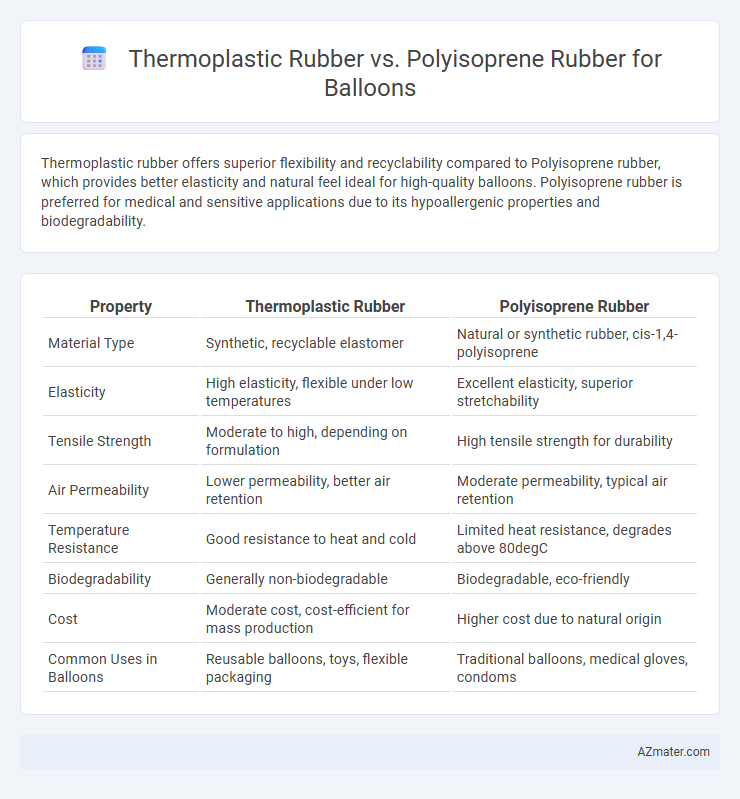Thermoplastic rubber offers superior flexibility and recyclability compared to Polyisoprene rubber, which provides better elasticity and natural feel ideal for high-quality balloons. Polyisoprene rubber is preferred for medical and sensitive applications due to its hypoallergenic properties and biodegradability.
Table of Comparison
| Property | Thermoplastic Rubber | Polyisoprene Rubber |
|---|---|---|
| Material Type | Synthetic, recyclable elastomer | Natural or synthetic rubber, cis-1,4-polyisoprene |
| Elasticity | High elasticity, flexible under low temperatures | Excellent elasticity, superior stretchability |
| Tensile Strength | Moderate to high, depending on formulation | High tensile strength for durability |
| Air Permeability | Lower permeability, better air retention | Moderate permeability, typical air retention |
| Temperature Resistance | Good resistance to heat and cold | Limited heat resistance, degrades above 80degC |
| Biodegradability | Generally non-biodegradable | Biodegradable, eco-friendly |
| Cost | Moderate cost, cost-efficient for mass production | Higher cost due to natural origin |
| Common Uses in Balloons | Reusable balloons, toys, flexible packaging | Traditional balloons, medical gloves, condoms |
Introduction to Balloon Materials
Thermoplastic rubber and polyisoprene rubber are popular materials used in balloon manufacturing due to their elasticity and durability. Thermoplastic rubber offers excellent flexibility, chemical resistance, and ease of processing, making it suitable for reusable or specialty balloons. Polyisoprene rubber, derived from natural latex, provides superior stretchability and biodegradability, making it ideal for traditional party balloons requiring high elasticity and environmental friendliness.
Overview of Thermoplastic Rubber
Thermoplastic rubber (TPR) offers a unique combination of rubber-like elasticity and the processing advantages of thermoplastics, making it ideal for balloon manufacturing. Its ability to be repeatedly melted and reshaped allows for efficient recycling and versatility in production, unlike traditional polyisoprene rubber which requires vulcanization. TPR also provides excellent durability and resistance to deformation, ensuring balloons retain their shape and elasticity under various conditions.
Overview of Polyisoprene Rubber
Polyisoprene rubber is a natural elastomer extracted primarily from rubber trees, boasting excellent elasticity, high tensile strength, and superior resilience compared to thermoplastic rubber. Its molecular structure closely mimics natural latex, providing exceptional flexibility, biocompatibility, and resistance to abrasion, which are essential qualities for durable and safe balloon applications. Polyisoprene's ability to maintain elasticity at varied temperatures and its low allergenic potential make it a preferred choice over thermoplastic rubber in medical and high-performance balloons.
Physical Properties Comparison
Thermoplastic rubber (TPR) exhibits superior elasticity and higher tensile strength compared to polyisoprene rubber, making it more resistant to deformation and tearing in balloon applications. Polyisoprene rubber offers excellent resilience and elongation, closely mimicking natural rubber, which provides a soft touch and high flexibility but lower abrasion resistance. The physical properties of TPR, such as better aging and chemical resistance, contribute to longer balloon durability under environmental stress, while polyisoprene excels in maintaining elasticity over multiple inflation cycles.
Elasticity and Flexibility Differences
Thermoplastic rubber (TPR) offers superior elasticity with a wide range of stretch and recovery, making it ideal for balloons that require repeated inflation and deflation without deformation. Polyisoprene rubber, closely mimicking natural rubber, provides excellent flexibility and resilience, allowing balloons to expand smoothly with minimal stress cracking. Elasticity in TPR depends on its molecular composition, resulting in higher durability under tension, whereas polyisoprene rubber excels in softness and spontaneous shape recovery due to its cis-1,4-polyisoprene structure.
Safety and Allergen Considerations
Thermoplastic rubber (TPR) offers superior hypoallergenic properties compared to polyisoprene rubber, making it a safer option for balloon users with latex allergies. Polyisoprene is chemically similar to natural rubber latex, posing potential allergen risks due to residual proteins, while TPR is a synthetic material with minimal allergenic potential. Selecting TPR balloons reduces the risk of allergic reactions, enhancing safety in environments requiring stringent allergen control.
Manufacturing Processes and Efficiency
Thermoplastic rubber (TPR) enables efficient balloon manufacturing through injection molding and extrusion, offering rapid cycle times and recyclability that reduce production costs and waste. Polyisoprene rubber, commonly processed via traditional vulcanization and molding, requires longer curing times and specialized equipment, impacting throughput and energy consumption. TPR's ability to be re-melted and reshaped enhances manufacturing flexibility and minimizes downtime compared to the more labor-intensive and time-consuming processes of polyisoprene rubber.
Durability and Performance in Use
Thermoplastic rubber (TPR) offers superior durability for balloons due to its excellent resistance to abrasion, weathering, and repeated stretching, ensuring longer-lasting performance. Polyisoprene rubber, while providing high elasticity and natural elasticity similar to latex, tends to degrade faster under UV exposure and repeated use, reducing balloon lifespan. For applications requiring resilient, reusable balloons, TPR demonstrates enhanced performance through its ability to maintain shape and strength over time.
Environmental Impact and Sustainability
Thermoplastic rubber (TPR) offers enhanced recyclability compared to polyisoprene rubber, making it a more sustainable choice for balloons due to its ability to be melted and reformed without significant degradation. Polyisoprene rubber, derived from natural latex, is biodegradable but its production involves extensive water use and potential deforestation, impacting environmental sustainability negatively. Considering lifecycle analysis, TPR balloons reduce waste accumulation in landfills, whereas polyisoprene balloons provide a more eco-friendly end-of-life solution via natural decomposition.
Cost Analysis and Market Preferences
Thermoplastic rubber (TPR) offers lower manufacturing costs and easier recyclability compared to polyisoprene rubber, making it a cost-efficient choice for balloon production. Polyisoprene rubber, while more expensive, provides superior elasticity and biodegradability, attracting environmentally conscious consumers and niche markets. Market preferences tend to favor TPR for mass-produced balloons due to budget constraints, whereas premium or eco-friendly segments prefer polyisoprene for its natural properties and performance.

Infographic: Thermoplastic rubber vs Polyisoprene rubber for Balloon
 azmater.com
azmater.com